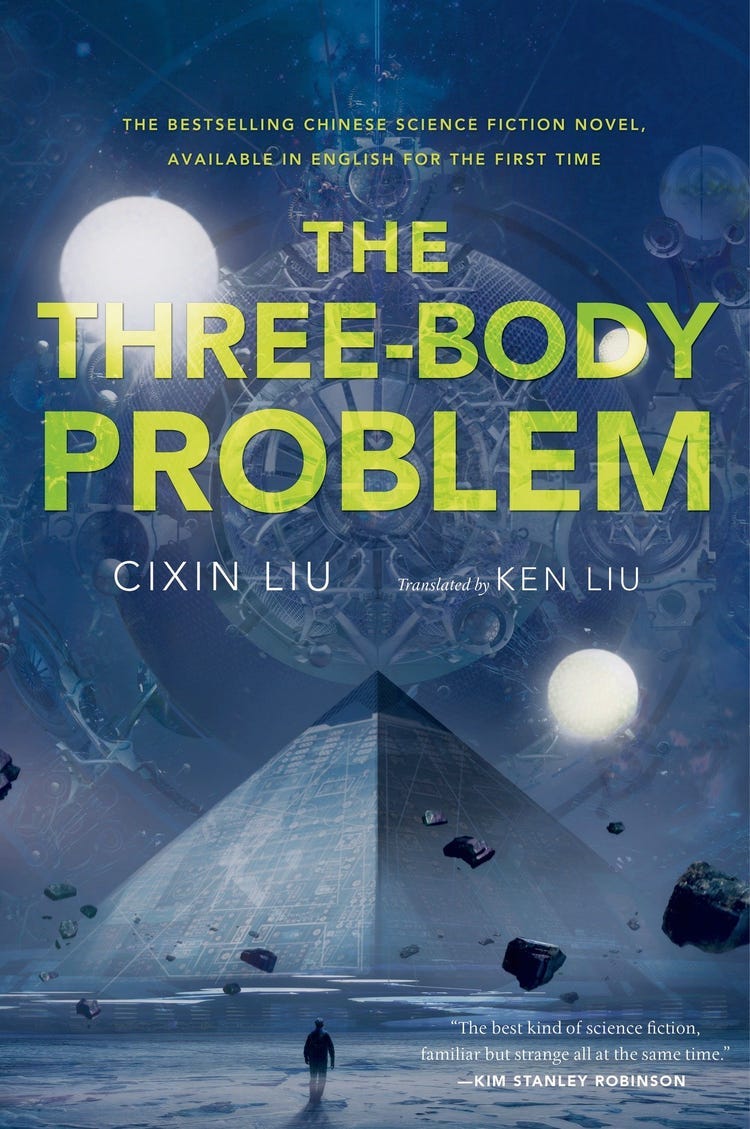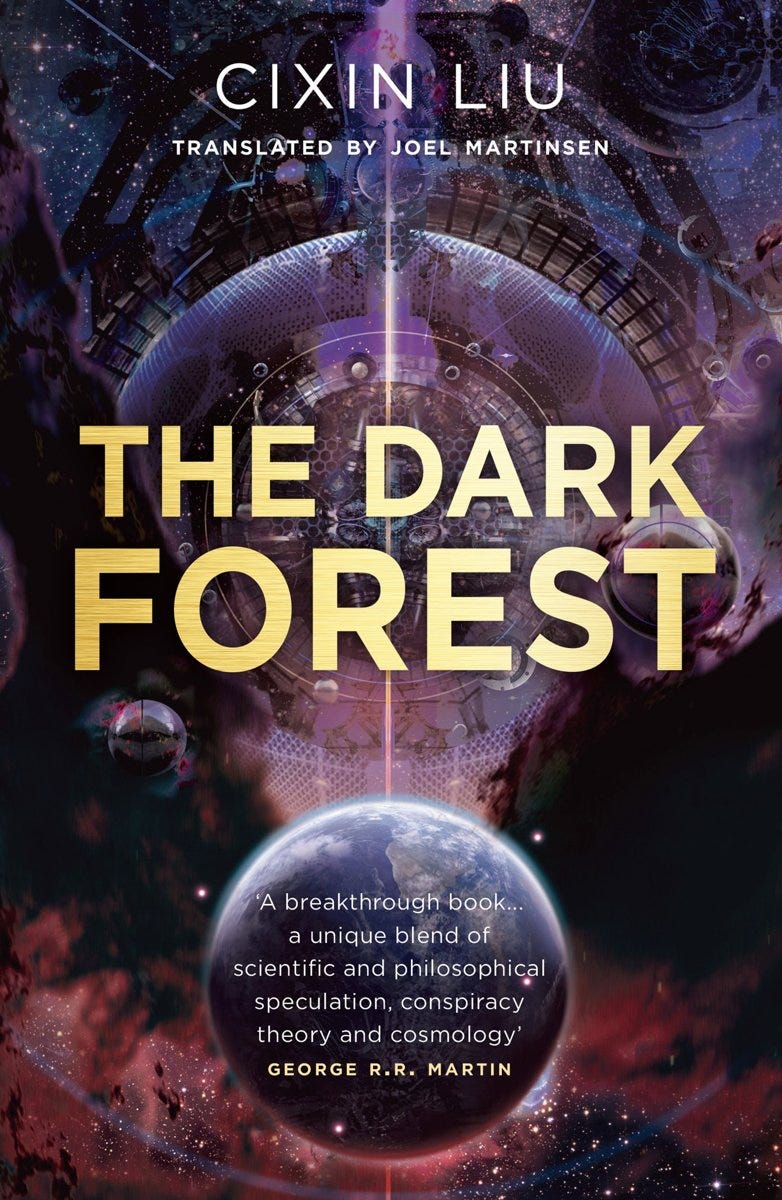The Three-Body Trilogy by Cixin Liu
An Exploration of Humanity, Science, and Extraterrestrial Contact
I read Cixin Liu's sci-fi novel "The Three-Body Problem" a few years ago and enjoyed it immensely. Now, with its adaptation into a TV series, I've decided to read the entire trilogy before watching the show, which from what I 've read has been has been overly westernized to appeal more to Western audiences. Although I haven’t watched it yet, I don’t think it helps the story because it is removed from its original context. Thus, if you're up for a challenge and wish to dig deep into its intricate plot, the complex characters and the in-depth engagement with scientific theories, existential questions and the nature of humanity, I recommend reading the books first. The trilogy spans 1500 pages, but the journey is rewarding.
The Remembrance of Earth's Past series as it is known the Three-Body trilogy by Cixin Liu, is a monumental work in the realm of science fiction. The trilogy, comprising "The Three-Body Problem," "The Dark Forest," and "Death's End," presents a narrative that intertwines scientific theory, existential questions, and the fate of humanity in the face of extraterrestrial contact. Cixin Liu's work has garnered international acclaim, not only for its scientific rigor and imaginative scope but also for its profound philosophical inquiries into the nature of civilization, survival, and progress.
The Three-Body Problem: Setting the Stage for Extraterrestrial Contact
The first book, The Three-Body Problem, introduces humanity's first contact with an alien civilization against the backdrop of China's Cultural Revolution. Ye Wenjie, an astrophysicist involved in a secret military project, makes a fateful decision that sets off a chain of events influencing the future of humanity. The novel delves into the psychological and social impacts of the impending Trisolarian invasion, using the three-body problem as a metaphor for chaos and unpredictability.
The title, refers to a challenging and unsolvable problem in physics concerning the motion of three celestial bodies under mutual gravitational influence. It is based on Newton’s Law of Universal Gravitation which states that every particle attracts each other particle with a force proportional to the product of their masses and inversely proportional to the square of the distance between their centres. The problem has been studied for centuries and it remains one of the most fascinating and challenging problems in classical mechanics.
The Dark Forest: Survival in a Hostile Universe
As the story progresses into The Dark Forest, Cixin Liu expands on the implications of first contact, introducing the chilling 'dark forest' theory." This theory suggests that there are many alien civilisations but they remain silent and undetectable to avoid destruction by other hostile civilisations.
This theory offers a potential solution to the Fermi Paradox – the perplexing question of why, despite the vastness of the universe, we have yet to encounter evidence of intelligent extraterrestrial life. The hypothesis assumes that any space-faring civilisation would view other intelligent life as a potential threat and would try to eliminate it to ensure their own survival . Therefore, the universe remains silent without evidence of intelligent alien life.
In the novel the universe is a vast, silent expanse akin to a dark forest, where countless alien civilisations lurk in the shadows, concealing their existence to avoid detection and potential annihilation by hostile forces. I was particularly struck by how Liu's portrayal of the 'dark forest' theory resonated with real-world issues like global surveillance and international relations.
Humanity faces an existential crisis, grappling with the knowledge of the Trisolaran fleet en route to Earth. In response, global efforts are mobilized to prepare for the impending invasion. The novel's protagonist, Luo Ji, is a reluctant hero, a sociologist and astronomer who becomes one of the key figures in devising a strategy to counter the Trisolaran threat.
Cixin Liu's portrayal of the "dark forest" reflects the real-world concept of existential risk were unknown threats could potentially annihilate humanity. Just as civilizations in the dark forest must remain hidden to survive, humanity mist navigate and mitigate existential risks like nuclear war, climate change and artificial intelligence.
Cixin Liu portrayal of the dark forest highlights how technological advancement can increase a civilisation’s (or a country’s) visibility and thus its risk of destruction. This mirrors the fragility of human civilisation, where rapid technological progress can lead to new vulnerabilities, such as cybersecurity threats, bioweapons or uncontrolled AI.
In the novel, Cixin Liu suggests that the interconnectedness of civilisation increases their collective risk. Indeed interconnectedness increases the collective risk in various ways: The 2008 financial crisis, for example, started in the US, but quickly spread to other countries causing a global economic downtown. Environmental degradation in one region can have worldwide effects. The deforestation of the Amazon rainforest, often referred to as the "lungs of the Earth," it affects the shole planet because it plays a critical role in the global carbon cycle and climate regulation. Climate change, driven by industrial activities across the globe and us, humans driving our cars, leads to more frequent and severe natural disasters, which affect everyone in the world and especially those who are least responsible. And as we experienced recently , the Covid-19 pandemic has been a profound demonstration of the interconnected nature of our world, highlighting both the strengths and the weaknesses of this interconnectedness and the necessity for global cooperation to respond to global challenges.
Just as civilizations in the dark forest must find ways to ensure mutual survival, humanity must collaborate globally to address shared threats and challenges and preserve our fragile planet.
The novel explores the psychological burden of this knowledge, as well as the ethical dilemmas faced by humanity in its struggle for survival. The narrative is marked by moments of profound insight into human nature, as well as the stark realization that the survival of civilization may require harsh and morally ambiguous decisions, such as the Luo Ji’s decision to create a deterrent by broadcasting the coordinates of the Trisolaris system to the universe, which could lead to the destruction of both world.
This strategy shares similarities with the strategies employed during the Cold War between the United States and the then USSR. Both The Dark Forest and the Cold War, relied in the principles of deterrence, secrecy and the threat of mutual destruction (MAD), highlighting the strategic considerations, the central role of certain individuals, and the delicate balance required to avoid a catastrophic conflict.
This strategy places an immense psychological burden to a few individuals – in The Dark Forest on Luo Ji, but it also raises question about the morality of such decision: maintaining peace through the constant threat of mutual destruction.
Death's End: The Ultimate Confrontation
The final book in the trilogy, Death's End, takes an ambitious, cosmic perspective, and brings the epic narrative to a climactic conclusion, spanning vast stretches of time and space. The novel explores the ultimate consequences of the contact between humanity and the Trisolarans, as well as the broader implications for the universe itself.
In this final novel, Cixin Liu probes into mind-bending scientific concepts, such as higher-dimensional space, the speed of light, and the nature of consciousness, pushing the boundaries of speculative fiction.
The novel suggests that consciousness may evolve to be more malleable, transcendent and intertwined with cosmos in ways that currently cannot comprehend. Sophons – microscopic proton based computers that can manipulate space-time and fundamentally alter the laws of physics- become a higher-dimensional consciousness that transcends our 3D reality. Cixin Liu basically challenges readers to rethink their assumptions about the nature of awareness and sentience.
The idea of civilisations ascending to higher dimensions is a fascinating concept and a staple of science-fiction. In theoretical physics, there are models such as string theory that propose the existence of more than the three spatial dimensions we experience in our daily lives. Even if higher dimensions do exist, and could be accessed, it’s unclear what it would mean for humans to exist in them. Our biology, chemistry and technology are all built around the physics of three spatial dimensions and one time dimension. Existing in a higher- dimension space would require fundamentally different biology and technology. Also, a universe with two time dimensions is conceptually challenging to grasp. Instead of a single timeline, there could be an infinite number of parallel timelines or alternative realities branching off in the second time direction, similar to the ”many worlds” interpretation of quantum mechanics.
Throughout the trilogy, Cixin Liu weaves a tapestry of philosophical and scientific themes that elevate the narrative beyond conventional science fiction. Cixin Liu's narrative is characterized by its grand scale and imaginative scope, envisioning a future where humanity must grapple with the fundamental nature of existence. Using complex concepts from physics, astronomy, and mathematics, he makes the narrative intellectually stimulating, and challenges readers to contemplate the limits of our knowledge and ingenuity, as well as the vastness of the universe, while also offering a poignant reflection on the transient nature of civilization.
Sociopolitical Commentary: Throughout the trilogy, Liu examines various sociopolitical dynamics, both on a global and interstellar scale. The series portrays humanity's response to an existential threat, revealing the strengths and weaknesses of different political systems and ideologies. The formation of the Earth-Trisolaris Organization (ETO) and the differing approaches of nations and groups reflect real-world geopolitical tensions and the complexities of global cooperation.
Thank you for reading this Substack. If you think someone else might enjoy this too, please spread the word. If you have any feedback, please comment below.






